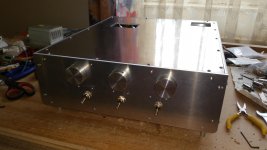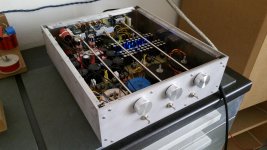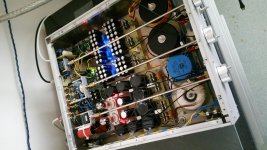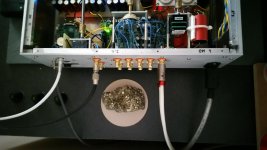Now I consider to do the same just without the LM 1084. I am thinking, that there is a regulator onboard anyway- so- wouldn't building that way, give similar or even better results?
I think the answer depends on who you ask.
The dam1021 also has onboard rectification, so you can feed it AC (in the right voltage range) straight from your transformer. Or you can power it with regulated DC, as you have done. And of course, regulators vary in their quality. You could use discrete LDOs, as you currently are. At least in terms of specs, the LT3042 looks to be one of the better LDOs currently available. And then there are countless discrete circuits, for example the highly regarded shunt power supplies by Salas... and everything in between.
Does it make a difference? I haven't personally done much in the way of comparing, but having read all of this thread, and numerous other threads over the net, and there is no shortage of subjective reports of improvements with increasing power supply quality. And if you're really concerned about power quality, you can bypass the dam1021 onboard regulators and power the specific circuits directly however you want (e.g. batteries).
The real answer is "try it and see".
Hi Matt_Garman!
Thanx for your opinion!
Have to admit, that I'm a little bit lazy at the moment- probably caused by unusually deep temperatures in my region;-)
I fully agree, that real insight is only to achieve by getting results out of own experiments. I will try it out and compare.
My consideration was based on the assumption, that fast rectifying and solid filtering of the demanded DC-current would make life easy enough for the following onboard-regulator circuit (that I won't cut out).
I researched the LT3042 and found, that 200mA would be too limited for solid powering of the DAM.
I personally made the experience, that a heavy transformer (2*4,2 Ampere's in my case), modern 'soft-recovery'-rectifying, ultra-stable filtering (I'm using Panasonic's FM-types- many in parallel), some ultrafast bypass-caps on both sides near the LM 1084 in synergy lead to overwhelming results.
Clean Current- as 'fast' as possible- that's my way to go;-)
One could rate this strategy as complete overkill, of course. But to me it brought beating success and pleasureful listening;-)
Greetingz, Robert
Thanx for your opinion!
Have to admit, that I'm a little bit lazy at the moment- probably caused by unusually deep temperatures in my region;-)
I fully agree, that real insight is only to achieve by getting results out of own experiments. I will try it out and compare.
My consideration was based on the assumption, that fast rectifying and solid filtering of the demanded DC-current would make life easy enough for the following onboard-regulator circuit (that I won't cut out).
I researched the LT3042 and found, that 200mA would be too limited for solid powering of the DAM.
I personally made the experience, that a heavy transformer (2*4,2 Ampere's in my case), modern 'soft-recovery'-rectifying, ultra-stable filtering (I'm using Panasonic's FM-types- many in parallel), some ultrafast bypass-caps on both sides near the LM 1084 in synergy lead to overwhelming results.
Clean Current- as 'fast' as possible- that's my way to go;-)
One could rate this strategy as complete overkill, of course. But to me it brought beating success and pleasureful listening;-)
Greetingz, Robert
Last edited:
Here some pics of my soekris-build-up; not yet ready, but stunningly playing;-)
That is one fantastic built, probably the most impressive I've seen so far, congratulations with the work done.
That is one fantastic built, probably the most impressive I've seen so far, congratulations with the work done.
Soren,
Would you mind sharing a photo of you balanced dual dam1121?
Here some pics of my soekris-build-up; not yet ready, but stunningly playing;-)
That looks great! Thanks for posting!
Have to admit, that I'm a little bit lazy at the moment- probably caused by unusually deep temperatures in my region;-)
Given how much work clearly went into the build you posted, I think it's unfair to call yourself lazy.

I researched the LT3042 and found, that 200mA would be too limited for solid powering of the DAM.
FYI, you can get more current out of the LT3042 by stringing multiples together in parallel. Check out diyAudio member opc's The Wire LT3042 Parallel Reg PSU. Another approach to get more current out of the LT3042 is to add a transistor, like the DIYINHK power supplies. That's what I happen to be using now, although I plan to change to a pair of Sigma11 supplies (actually, a custom smaller implementation of the s11 circuit, waiting on the boards to be delivered). I also have some Salas BIB power supplies, but I'm hesitant to use them due to the heat production.
I don't really expect any sound quality improvement, but I get to say it's "more DIY" using a PSU I assembled rather than a drop-in off-the-shelf module.
Thanx Matt_Garman for contributing to my consideration! Will check that.
Thanx to All for your kind words!
It's not ready yet- still in test-mode;-) External and also internal look will change as some circuits are getting further optimized.
But one's for sure- this thing killed my summer last year;-)
Greetingz, Robert
Thanx to All for your kind words!
It's not ready yet- still in test-mode;-) External and also internal look will change as some circuits are getting further optimized.
But one's for sure- this thing killed my summer last year;-)
Greetingz, Robert
Hi. Has anyone tried feeding dam soekris with two stacked (bipolar) LPS-1 from uptone?
I just finished an adapter to do so last night. Will try sometime this weekend or next week
Greg in Mississippi
Hi Matt_Garman!
Thanx for your opinion!
Have to admit, that I'm a little bit lazy at the moment- probably caused by unusually deep temperatures in my region;-)
I fully agree, that real insight is only to achieve by getting results out of own experiments. I will try it out and compare.
My consideration was based on the assumption, that fast rectifying and solid filtering of the demanded DC-current would make life easy enough for the following onboard-regulator circuit (that I won't cut out).
I researched the LT3042 and found, that 200mA would be too limited for solid powering of the DAM.
I personally made the experience, that a heavy transformer (2*4,2 Ampere's in my case), modern 'soft-recovery'-rectifying, ultra-stable filtering (I'm using Panasonic's FM-types- many in parallel), some ultrafast bypass-caps on both sides near the LM 1084 in synergy lead to overwhelming results.
Clean Current- as 'fast' as possible- that's my way to go;-)
One could rate this strategy as complete overkill, of course. But to me it brought beating success and pleasureful listening;-)
Greetingz, Robert
Look at OPC's 'Wire' paralleled LT3042 board. He's pretty busy right now and can be slow to answer and ship, but it gives you two separate regulators that parallel 4 LT3042 each. It has worked well for me in some past appplications, but it IS a DIY board and the soldering is challenging.
***EDIT*** I just saw that Matt G had posted a link to OPCs thread. I CAN attest Owen is still alive and kicking, had a couple of email exchanges with him over the holidays.
One thing I like about his board is that it gives you about 1A output capability in the real world.
Also having 2 full regulator circuits on each board means you can use them as a split +- supply with one having the positive connected to ground and ground to negative.
AND with on-board rectification you can power them from AC.
AND they will go down to 1.2V (Guess where I plan to use one?).
And I like that each of the 2 reg circuits on each board is backed up with almost 18,000uf of capacitance.
I have 4 of these boards built up for my next set of mods to my 2 DAMs, another for a further mod to my Sony HAP Z1-ES, and another to try paralleling both sides as a super-quiet moderate current low-drop-out supply for an R-Pi.
Can you tell I like them?
Greg in Mississippi
Last edited:
I just finished an adapter to do so last night. Will try sometime this weekend or next week
Greg in Mississippi
Let us know Greg about results.
Although overall sound will be dominated with onboard regs still low noise and impedance PSU in front of dam1021 has huge impact.
I am actually wonder how LPS-1 compares to well build shunt like Salas SSLV or Reflector D in this position and in general.
Let us know Greg about results.
Although overall sound will be dominated with onboard regs still low noise and impedance PSU in front of dam1021 has huge impact.
I am actually wonder how LPS-1 compares to well build shunt like Salas SSLV or Reflector D in this position and in general.
as you say
overall sound will be dominated with onboard regs and caps
would you not be better to tackle each device separately
as you say
overall sound will be dominated with onboard regs and caps
would you not be better to tackle each device separately
I already did nige
Here I was just curious how LPS-1 compares to Shunts when powering Soekris board at e.g: -/+7V.
I am also curious how LPS-1 compares to LiFePo4, but this would be a question more for you
Last edited:
I already did nigeI got separate well modded shunt regs (Salas Ref Ds), for every place: clock 3.3V, -/+4V vref and 1.2V belleson for fpga - it really brings soekris to new level.
Here I was just curious how LPS-1 compares to Shunts when powering Soekris board at -/+7V.
I am also curious how LPS-1 compares to LiFePo4, but this would be a question more for youAny thoughts?
not absolutely certain
but did a little of supercap 100f vs a123 lifepo4 cell before
and much preferred the cell
maybe more caps might help
but in saying that the supercaps are good too
why dont you build your own bank of super caps, and tackle same points
isnt that all the lps-1 is
as you say
overall sound will be dominated with onboard regs and caps
would you not be better to tackle each device separately
Agreed.
Think of the LPS-1 as a good TPS7A4700-regulated supply fed from fairly low output impedence Ultracaps, and totally disconnected from the mains on the output side.
That last bit seems to work very well in situations where not being connected to the AC line interrupts the circulating AC currents that flow from one piece of gear to another through their AC-connected power supplies.
They work much the same as direct-connected batteries that are not being charged from the AC line. But of course, to do so in their 'automatic Ultracap bank-charging/swapping mode' takes a bit if circuitry and hence their related cost.
I (like many others) have found the biggest improvements and best results come when they are used to power the endpoint interfaces (R-Pi player computer, Allo Kali I2S reclocker in my setup) in a computer-sourced setup, even a networked one where I have a fully galvanically-isolated fiber ethernet leg as the last segment before the endpoint player. In this enviroment, they have also worked wonders powering some low-end-ish DAC cards
So powering DACs like the Soekris should be a good fit. I plan to try them in the following sequence of experiments:
1st - Using 2 LPS-1s to replace the +-14v feed from 2 good linear supplies into DAMs with basically stock onboard power supplies, but with modified VREF supplies and output from the direct feed with all of the output opamp circuitry removed.
2nd - Removing the 4 on-board power supplies and regulator chips (1.2v, 3.3v, +-5v) and use 4 LPS-1s to feed 2 dual OPC paralleled LT3042 boards, with one set to 1.2v & 3.3v and the other with both sides set to 5v and setup to power the +-5v feeds to the VREG supplies.
3rd - Revising the 2nd setup by inserting the Tir Na HiFi-standard float-charged LiFePO4 cells, with 1 on the output of the 3.3v OPC reg, 1 float-charged by an LPS-1 set to 3.3v on the input of the 1.2v OPC reg, and 2 setup in a +-3.3v float-charged configuration fed by an OPC reg pair set to 3.3v for each side and bypassing the VREF sources.
Finally, at some point I'll have to power the 3rd configuration with 4 3.3v AC-connected linear supplies in the standard Tir Na HiFi configuration to see if the LPS-1s offer any added benefit.
We'll see how it all works out!
Greg in Mississippi
Greg, Nige,
Reading your posts makes me feel I am not the only crazy one
I went shunt regs path (Salas Ref D) due to following reasons:
- claimed noise to be down to nanoVolts
- impedance well below 1mOhm! at least from the plots
- wide bandwidth due to zobel network
For build I tried many capacitors like Silmics II, Black Gates, OSCONS and ended up with 4 pin ones. In same datasheets they claim dampening HF 11db better the regular caps.
I use them in two places: main reservoir and for Vref LED filtering, where they do excel.
For powering audio grade trafo with electrostatic shields between primary and secondary.
Seems like each of use when quit different path: shunts, lifepo4, supercaps.
Would be very interesting to compare dam1021 in those different powering approaches.
Reading your posts makes me feel I am not the only crazy one
I went shunt regs path (Salas Ref D) due to following reasons:
- claimed noise to be down to nanoVolts
- impedance well below 1mOhm! at least from the plots
- wide bandwidth due to zobel network
For build I tried many capacitors like Silmics II, Black Gates, OSCONS and ended up with 4 pin ones. In same datasheets they claim dampening HF 11db better the regular caps.
I use them in two places: main reservoir and for Vref LED filtering, where they do excel.
For powering audio grade trafo with electrostatic shields between primary and secondary.
Seems like each of use when quit different path: shunts, lifepo4, supercaps.
Would be very interesting to compare dam1021 in those different powering approaches.
Last edited:
Agreed.
Think of the LPS-1 as a good TPS7A4700-regulated supply fed from fairly low output impedence Ultracaps, and totally disconnected from the mains on the output side.
That last bit seems to work very well in situations where not being connected to the AC line interrupts the circulating AC currents that flow from one piece of gear to another through their AC-connected power supplies.
They work much the same as direct-connected batteries that are not being charged from the AC line. But of course, to do so in their 'automatic Ultracap bank-charging/swapping mode' takes a bit if circuitry and hence their related cost.
I (like many others) have found the biggest improvements and best results come when they are used to power the endpoint interfaces (R-Pi player computer, Allo Kali I2S reclocker in my setup) in a computer-sourced setup, even a networked one where I have a fully galvanically-isolated fiber ethernet leg as the last segment before the endpoint player. In this enviroment, they have also worked wonders powering some low-end-ish DAC cards
So powering DACs like the Soekris should be a good fit. I plan to try them in the following sequence of experiments:
1st - Using 2 LPS-1s to replace the +-14v feed from 2 good linear supplies into DAMs with basically stock onboard power supplies, but with modified VREF supplies and output from the direct feed with all of the output opamp circuitry removed.
2nd - Removing the 4 on-board power supplies and regulator chips (1.2v, 3.3v, +-5v) and use 4 LPS-1s to feed 2 dual OPC paralleled LT3042 boards, with one set to 1.2v & 3.3v and the other with both sides set to 5v and setup to power the +-5v feeds to the VREG supplies.
3rd - Revising the 2nd setup by inserting the Tir Na HiFi-standard float-charged LiFePO4 cells, with 1 on the output of the 3.3v OPC reg, 1 float-charged by an LPS-1 set to 3.3v on the input of the 1.2v OPC reg, and 2 setup in a +-3.3v float-charged configuration fed by an OPC reg pair set to 3.3v for each side and bypassing the VREF sources.
Finally, at some point I'll have to power the 3rd configuration with 4 3.3v AC-connected linear supplies in the standard Tir Na HiFi configuration to see if the LPS-1s offer any added benefit.
We'll see how it all works out!
Greg in Mississippi
dunno if i see the point of the cap charge/ drain swap thing,
maybe if the ps system were poor
if you use a good supply into the super caps id guess it would be fine
that way you can power direct from supercaps and not be inhibited by bottlenecking with a regulator
theres very little benefit in feeding the 5v regs better to go direct to vref
Greg, Nige,
For build I tried many capacitors like Silmics II, Black Gates, OSCONS and ended up with 4 pin ones. In same datasheets they claim dampening HF 11db better the regular caps.
I use them in two places: main reservoir and for Vref LED filtering, where they do excel.
lost me here......
what caps did u end up using?
I just finished an adapter to do so last night. Will try sometime this weekend or next week
Greg in Mississippi
You will be feeding DAM1021 with +7 / -7 V ?
Output from RAW or buffers?
bypassing on-board bridge?
- Home
- Vendor's Bazaar
- Reference DAC Module - Discrete R-2R Sign Magnitude 24 bit 384 KHz



